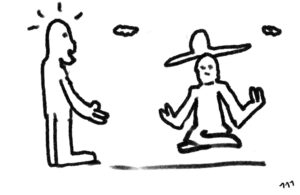You probably wonder : How Do I Move On With Life?
Feel the breathe that comes in.
Feel the air that comes out.
Let’s go.
Key takeaways
![]() Let go off past from NOW.
Let go off past from NOW.
![]() YOU are NOT alone.
YOU are NOT alone.
![]() Stay conscious of everything you DON’t know.
Stay conscious of everything you DON’t know.
How do I move on with life ?

Change, the inevitable tide, washes over us, leaving us gasping for the familiar. Yet, in its ebb and flow, we find growth.
To navigate these waters, we must master the art of letting go, a skill both delicate and powerful.
It begins within, as we learn to release the anchors of our past sorrows and joys alike, acknowledging their part in our story, but not letting them steer the ship.
Transitioning to life after loss is akin to painting on a renewed canvas. The hues may change, but the artistry remains.
We reimagine our world, not as a replication of the past, but as an exploration of what can be. It’s a world where memories exist, not as shadows that dim our path, but as stars that guide our journey.
- Release Techniques:
- Mindfulness meditation
- Journaling for emotional release
- Engaging in creative outlets like art or music
- Reimagination Strategies:
- Setting new personal goals
- Exploring different hobbies and interests
- Redecorating living spaces to reflect new beginnings
As we traverse this path, we weave the narrative of our resilience, threading the needle through experiences that both challenge and define us.
We learn the patience of transformation, that healing, much like the moon’s phases, is a gradual revelation of light in the darkness.
It’s understanding that the clock’s hands move in tandem with our heartbeat, syncing with the universe’s timeless rhythm.
- Healing Milestones:
- Recognizing and celebrating small victories
- Reflecting on growth at regular intervals
- Practicing gratitude for the journey thus far
To move on is to embrace the flux of life, to see change not as a foe, but as a catalyst for the unfolding of one’s potential.
It is to walk with confidence into the dawn of a new chapter, eyes wide with wonder for the horizons of hope that await.
What are the Steps to Move On?
Moving on from challenging situations or significant life changes involves a process of emotional, psychological, and sometimes physical adjustments.
The journey of moving on can be articulated through various steps, strategies for embracing new beginnings, and key milestones that signify progress. Below is an expanded discussion on these aspects, including a table that summarizes the key points.
Identifying the Process of Letting Go
The process of letting go is crucial in moving on. It involves recognizing and accepting that some aspects of our lives—relationships, jobs, beliefs, or personal identities—may no longer serve us or fit with our current circumstances or future aspirations.
Letting go is not about forgetting or diminishing past experiences but rather about acknowledging their impact and making a conscious decision to release their hold on our emotional and mental well-being. This can involve:
- Acknowledging feelings of loss, grief, or disappointment without judgment.
- Reflecting on what the past situation taught you and how it contributed to your growth.
- Actively deciding to release the emotional attachment to that past, which may involve rituals, symbolic gestures, or therapeutic practices like writing letters (not necessarily to be sent) expressing your feelings.
Strategies for Embracing New Beginnings
Embracing new beginnings is about opening yourself up to new experiences, opportunities, and ways of being. It can be both exhilarating and daunting. Strategies to facilitate this include:
- Setting new goals and identifying what you want your life to look like moving forward.
- Trying new activities or revisiting past interests that you may have neglected.
- Cultivating a mindset of curiosity and openness, viewing new experiences as opportunities for learning and growth.
Key Milestones in the Journey of Moving On
Milestones in moving on are personal and varied but generally represent significant points of progress in your journey.
They might include:
- The first time you feel joy or happiness after your loss without it being overshadowed by sadness.
- Engaging in a new activity or pursuing a new goal that was inspired by your process of moving on.
- Reaching a point where memories of the past no longer bring significant pain or disruption to your emotional state.
Below is a table summarizing these steps, strategies, and milestones:
| Aspect | Description | Examples |
|---|---|---|
| Letting Go | Recognizing and releasing emotional attachments to the past. | – Acknowledging emotions without judgment.
– Reflective practices like journaling. – Decision to release attachment. |
| Embracing New Beginnings | Opening up to new experiences and redefining life goals. | – Setting new personal or professional goals.
– Trying new activities. – Adopting a mindset of curiosity. |
| Key Milestones | Significant points that indicate progress in the journey of moving on. | – Experiencing joy that’s not overshadowed by past sadness.
– Pursuing new goals inspired by your growth. – Memories of the past no longer causing significant emotional pain. |
Moving on is a deeply personal journey that unfolds differently for everyone. It requires time, patience, and self-compassion.
While the steps, strategies, and milestones outlined here provide a framework, it’s important to remember that moving on is not a linear process, and it’s okay to have moments of setback along the way.
How do I Really move on in this life ?
Time is your friend.
Time is the silent narrator of our lives, unfaltering and unbiased. As clock hands move in harmony with our heartbeats, we are reminded that healing is not a race, but a rhythm to be respected.
The synchrony between time and transformation is a delicate ballet, one where patience plays the lead role. It is in this dance we learn that the tick of the clock need not be a metronome for our grief but a companion in our journey.
The road to recovery is paved with the pebbles of patience. Each moment of stillness, each silent acknowledgment of pain, contributes to a greater fortitude. Patience does not mean idleness; it is the active acceptance of time’s pace.
- Engage in reflective practices like meditation to appreciate the present.
- Celebrate small victories, for each, is a triumph over the past.
- Understand that setbacks are not failures, but part of the healing tapestry.
As we align with time’s tempo, we discover that our scars are not just reminders of what we’ve endured, but of the strength we’ve garnered through perseverance.
Love is life.

Grief is a landscape that must be navigated with care, its terrain rugged and unwieldy.
Yet, as we traverse this land, our steps, however faltering, chart a path toward renewal. Each day is a new coordinate on the timeline of healing, a chance to move closer to a place of peace.
The timeline of healing is unique to each soul. It is not a straight line but a spiral, often circling back upon itself, allowing us to revisit and reassess our wounds from newfound heights of understanding.
- Implement daily rituals that foster a sense of continuity and comfort.
- Lean on creative outlets to express the inexpressible, giving form to the formless.
- Seek out stories of others who have journeyed through grief, finding solace in shared humanity.
In the fullness of time, growth emerges, not despite our grief, but because of it. We grow not to leave behind our loss, but to let it evolve into new forms of love and memory.
The Compass of Self-Discovery: Navigating Your Inner Landscape
Finding Who You Are Beyond the Pain
In the quiet aftermath of upheaval, a quest beckons — a journey not across vast oceans but within the intricate corridors of your being.
It is a pilgrimage to the core of your identity, where you discover that beyond the pain lies a mosaic of traits, strengths, and potential.
This internal expedition requires tools not of steel and flame, but of introspection and courage:
- Delve into past achievements to remind yourself of your capabilities.
- Embrace new experiences to define interests that resonate with your essence.
- Cultivate mindfulness to maintain a connection with your inner narrative.
By undertaking this quest, you piece together the fragmented self, finding wholeness in the tapestry of who you are becoming.
Charting the Unseen: Uncovering Strengths and Dreams
The map to our dreams is often inked in invisible lines, etched by the quiet desires of our hearts. To chart this unseen world, we must first believe in its existence and then dare to bring it to light.
| Exploration Activity | Insight Gained | Dream Fulfilled |
|---|---|---|
| Skill Assessments | Unveils hidden talents | Guides career aspirations |
| Vision Boards | Visualizes deepest desires | Manifests personal goals |
| Adventure Seeking | Reveals passion for discovery | Leads to a fulfilling lifestyle |
With each endeavor, our strengths emerge, and dreams once shrouded in mist become clear, guiding us to our destiny.
Crafting Your Tomorrow: The Power of Goal Setting
Blueprint of Dreams: Sketching Out Your Future
Setting goals is akin to drafting a blueprint; it is the first stroke in the art of future-building. The act of putting pen to paper and outlining your dreams is both liberating and daunting, yet absolutely essential. In this phase, you’re an architect, envisioning structures of success in the mind’s eye before they’re built in reality.
- Reflect on your core values and how they align with your aspirations.
- Create a vision board to tangibly represent your ambitions.
- Write down your goals in detail, assigning timelines to each.
Through this process, the intangible whispers of our dreams are given voice and substance, setting the stage for action.
Milestones and Stepping Stones: Setting Achievable Targets
Achievable targets are the milestones that mark our journey towards grand aspirations. They are the stepping stones that allow us to wade through the currents of discouragement and keep our eyes on the prize. By breaking down our ultimate goals into smaller, more manageable tasks, we create a ladder of success.
- Identify the key steps needed to reach your larger goals.
- Establish short-term objectives that are specific, measurable, attainable, relevant, and timely (SMART).
- Regularly review your progress and adjust your targets as needed.
In this way, every small achievement is a brushstroke in the masterpiece that will become your future.
Cultivating Resilience: Rising with the Morning Sun
Weaving a Tapestry of Tenacity: The Fibers of Resilience
Resilience is the fabric that holds us together when the world seems bent on pulling us apart. It’s woven from the fibers of our experiences, dyed in the colors of our unique struggles, and patterned by our individual responses to adversity. To cultivate resilience is to weave this tapestry with intention, choosing threads that represent strength, flexibility, and recovery.
- Engage in regular self-reflection to understand your reactions to challenges.
- Foster a growth mindset that views obstacles as opportunities for learning.
- Maintain a supportive network that reinforces your resilience narrative.
This intricate tapestry, once complete, drapes us in the armor of tenacity, ready to face life’s battles with grit and grace.
The Alchemy of Adversity: Transforming Challenges into Opportunities
The crucible of life melts down our experiences, separating the dross from the pure substance. This alchemical process transforms challenges into gleaming opportunities, where each trial becomes a chance for transcendence. Adversity, in its fierce heat, has the power to forge us into something stronger, something more resilient.
| Challenge Type | Alchemical Process | Opportunity Created |
|---|---|---|
| Personal Loss | Reflection and Acceptance | Growth in Empathy |
| Professional Setback | Skill Assessment and Learning | Career Advancement |
| Health Issues | Adaptation and Perseverance | Enhanced Well-being |
Through this transformative process, we emerge not as victims of our circumstances, but as architects of our own fortitude, with each challenge adding to the strength of our character.
Cultivating Resilience: Rising with the Morning Sun
Weaving a Tapestry of Tenacity: The Fibers of Resilience
Resilience is the fabric that holds us together when the world seems bent on pulling us apart. It’s woven from the fibers of our experiences, dyed in the colors of our unique struggles, and patterned by our individual responses to adversity. To cultivate resilience is to weave this tapestry with intention, choosing threads that represent strength, flexibility, and recovery.
- Engage in regular self-reflection to understand your reactions to challenges.
- Foster a growth mindset that views obstacles as opportunities for learning.
- Maintain a supportive network that reinforces your resilience narrative.
This intricate tapestry, once complete, drapes us in the armor of tenacity, ready to face life’s battles with grit and grace.
The Alchemy of Adversity: Transforming Challenges into Opportunities
The crucible of life melts down our experiences, separating the dross from the pure substance. This alchemical process transforms challenges into gleaming opportunities, where each trial becomes a chance for transcendence. Adversity, in its fierce heat, has the power to forge us into something stronger, something more resilient.
| Challenge Type | Alchemical Process | Opportunity Created |
|---|---|---|
| Personal Loss | Reflection and Acceptance | Growth in Empathy |
| Professional Setback | Skill Assessment and Learning | Career Advancement |
| Health Issues | Adaptation and Perseverance | Enhanced Well-being |
Through this transformative process, we emerge not as victims of our circumstances, but as architects of our own fortitude, with each challenge adding to the strength of our character.
The Fellowship of Healing: Building Your Support Network
Bridges to Others’ Shores: Forming Bonds That Heal

Human connections are the bridges that span the chasms of our individual islands, bringing us together in a fellowship of healing. These bonds, forged in compassion and understanding, serve as conduits for shared strength and collective recovery.
- Seek out individuals who resonate with your journey and offer mutual support.
- Engage in community groups that align with your values and experiences.
- Cultivate relationships that provide a safe space for vulnerability and healing.
In the architecture of our lives, each bridge to another’s shore is a lifeline, a testament to the healing power of connection.
In the Company of Companions: The Role of Community in Healing
Communal bonds provide a symphony of support, each member’s voice a note in the harmony of recovery. In the company of companions, we find solace and strength, as our stories weave together, creating a tapestry of shared healing.
- Participate in group activities that encourage bonding and collective growth.
- Volunteer for causes that speak to your heart, building camaraderie in service.
- Embrace the diversity of your community, learning from the mosaic of its members.
The Serenity of Self-Care: Nurturing Body, Mind, and Soul
The Whispering Woods of Wellness: Paths to Personal Peace

In the whispering woods of wellness, each step is a choice toward tranquility. Here, self-care is the path we choose to tread, marked by actions that nurture our body, mind, and soul. This journey requires a commitment to personal rituals that ground us in serenity.
- Adopt a daily routine that includes physical activity for vitality and endurance.
- Practice meditation or deep breathing exercises for mental clarity.
- Engage in hobbies that nourish the soul and spark joy.
Walking these paths leads us to the heart of our own peace, where self-care is the natural rhythm of life.
Tending the Garden of Self: Daily Practices for Well-Being
To tend our garden is to care for our being with the tenderness of a gardener who knows that from well-tended soil, beauty blooms. Daily practices of well-being are the water and sunlight that ensure our growth, not just as individuals but as beings intertwined with the essence of life.
| Daily Practice | Benefit to Body | Benefit to Mind | Benefit to Soul |
|---|---|---|---|
| Balanced Diet | Nourishes cells | Fuels cognition | Satisfies senses |
| Adequate Sleep | Restores energy | Enhances mood | Promotes dreams |
| Meaningful Social Interaction | Strengthens immunity | Expands perspectives | Fosters connections |
Through these practices, we cultivate a life of balance and harmony, ensuring that each facet of our self is nurtured and cherished.
The Palette of Passions: Rediscovering Joy and Enthusiasm
Painting with Passion: Rekindling the Sparks of Interest
Passion paints our world in vibrant colors, transforming the mundane into the extraordinary. To rekindle it is to dip our brushes into the soul’s palette, finding joy in strokes both broad and nuanced. Reconnecting with our passions requires an exploration of what sets our hearts aflame.
- Experiment with new activities to discover hidden interests.
- Revisit past hobbies that once brought you happiness.
- Schedule regular ‘passion time’ to ensure consistent engagement and exploration.
In the rediscovery of our passions, we find the colors to paint our lives with renewed enthusiasm.
Melodies of the Heart: The Rhythm of Enjoying Life Again
Our passions are the melodies that make the heart sing, a rhythm that propels us to dance through life with a spring in our steps. Enjoying life again is about tuning into these melodies and letting them guide our daily cadence.
- Listen to music that uplifts your spirit and moves your body.
- Share your passions with others to multiply the joy.
- Reflect on the emotions and experiences that music and rhythm evoke.
As we sync with the melodies of our hearts, each day composes a symphony of joy that resonates with the rhythm of our truest selves.
The Horizon of Hope: Stepping into Your New Chapter
The Dawning of a New Day: Visions of a Hopeful Future

As dawn breaks, the horizon whispers promises of new beginnings. The canvas of tomorrow awaits our brush, ready to be painted with the hues of hope. Visions of a hopeful future are not mere daydreams but the blueprints from which we construct reality. This envisioning is an act of courage, a declaration that despite the night’s darkness, the sun shall rise again.
- Contemplate the possibilities that lie ahead, allowing yourself to dream boldly.
- Set intentions each morning that align with your vision of the future.
- Record your progress and the emotions that accompany new beginnings in a dedicated journal.
These acts of hope are seeds planted in the fertile soil of the soul, each one a potential for new growth.
The Journey Onward: Taking the First Steps into Tomorrow
With the horizon in sight, we stand at the threshold of action. Each step into tomorrow is a manifestation of our inner resolve, a physical embodiment of our mental map toward the future. The journey is both literal and figurative, a series of actions and reflections that pave the path to our aspirations.
| First Step | Significance | Anticipated Challenge | Strategy for Overcoming |
|---|---|---|---|
| Decision Making | Sets direction | Indecision | Reflective exercises |
| Action Taking | Initiates momentum | Procrastination | Small, manageable tasks |
| Habit Forming | Ensures consistency | Inconsistency | Routine and reminders |
By approaching each day as a micro-journey, we honor the grand voyage of life, appreciating the beauty in each moment of transition and transformation.
Conclusion
In the odyssey of life, each chapter we traverse is steeped in the essence of growth and renewal. From embracing change and setting goals to finding solace in solitude and the fellowship of others, we learn that life is a tapestry interwoven with threads of challenges and triumphs. Our journey through grief and self-discovery to the crafting of a resilient tomorrow underscores the perpetual cycle of healing and rebirth.
As we reach the horizon of hope, we do so not alone, but guided by the wisdom of shared experiences and the strength found in the collective human spirit. The steps we take into our new chapter are illuminated by the understanding that each moment of adversity is an opportunity for transformation and each act of self-care a tribute to our enduring spirit. May this essay serve as a compass for those navigating through their own personal metamorphoses, a reminder that the dawn of a new day is always within reach, and the journey onward is replete with infinite potential.